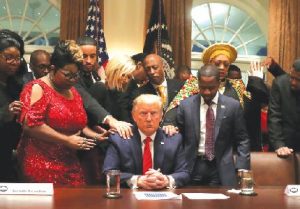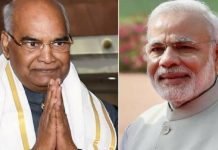 With only couple of days for the finale to the US presidential election scheduled for November 3, flurry of hectic political campaigning through electronic, print and social media, including rallies, is going on in both Republican and Democrats’ camps at a much rapid pace. Both Republican Party, also known as GOP (Grand Old Party) and Democratic Party have strained every nerve to attract voters through hectic campaigning by convincing them about their respective agenda to garner electorates’ support.
With only couple of days for the finale to the US presidential election scheduled for November 3, flurry of hectic political campaigning through electronic, print and social media, including rallies, is going on in both Republican and Democrats’ camps at a much rapid pace. Both Republican Party, also known as GOP (Grand Old Party) and Democratic Party have strained every nerve to attract voters through hectic campaigning by convincing them about their respective agenda to garner electorates’ support.
The incumbent Republican nominee is President Donald Trump who is seeking reelection and Joe Biden is the presidential nominee of the Democratic Party and the challenger. Joe Biden has been enjoying an edge over President Donald Trump in the opinion polls as well as leading in the ratings in the aftermath of first round of national debate held on 29 September 2020 as well as in second round of national debate held on 23 October 2020.
Nevertheless, this lead in ratings and opinion polls is in no way either an indicator or guarantee of success, and even garnering more popular votes’ lead over the rival candidate does not pave way for the Oval Office, unless an appropriate number of electoral votes are secured from the Electoral College, and these aspects are briefly appraised here.
Voters’ Profile
According to US Census Bureau, as of July 2019, total population of the US stood at around more than 328 million; and of these White Americans are the racial majority accounting for 76.3 per cent. Hispanic and Latino Americans are the largest ethnic minority, comprising an estimated 18 per cent of the population. African Americans are the second largest racial minority, constituting an estimated 13.4 per cent of the population. The other constituents include American-Indian and Alaska Native alone as 1.3 per cent, Asian-Americans- 5.9 per cent. There were approximately 4.16 million people of Indian descent in the US in 2018, with 2.62 million of them being US citizens. Out of them, 1.9 million citizens are eligible to vote in the upcoming election — 0.82 per cent of all eligible voters in the US.
Election Issues
In August 2020,Washington-based Pew Research Center conducted a survey of registered American voters to ascertain important issues in the 2020 Presidential Elections and according to the response and percentage following issues emerged: economy (79 per cent), healthcare (68 per cent), Supreme Court appointments (64 per cent), Covid-19 pandemic (62 per cent), violent crime (59 per cent), foreign policy (57 per cent), gun policy (55 per cent), race and ethnic inequality (52 per cent), immigration (52 per cent), economic inequality (49 per cent), climate change (42 per cent), and abortion (40 per cent).
A large part of these issues formed the subject matter of first national presidential debate held on 29 September 2020 between President DonaldTrump and Democrat nominee Joe Bidden. As per US media reports, in the final debate held on 23 October 2020 between Donald Trump and Joe Biden, the debate veered round following issues – fighting Covid-19,
American families, race in America, climate change, national security and leadership. Biden is reported to have gained an edge over President Trump in both the debates.
Mail-in Voting
Mail-in voting, also known as absentee voting or postal ballot, has been in vogue in the United States for a long time. Since the 2020 presidential election is being held at a time when the Covid-19 pandemic has already claimed over 2000, 000 American lives, a large number of electorate has preferred to mail-in voting mechanism and media reports show that by the middle of October 2020, more than 56 million people have already cast their votes by mail-in voting and there is possibility that 85 million people could cast vote before November 3. Approximately 240 million American citizens are eligible to vote this year.
The US has centuries long history of voting by mail. In the 17-century Massachusetts, people could vote from home if their homes were “vulnerable to Indian attack.”
Nevertheless, it as during the Civil Way that America first experimented with absentee voting on a bigger scale, and during the 1864 presidential election, Union soldiers were allowed to vote in camps and hospitals, under the supervision of clerks or state officials.
The absentee voting mechanism was permitted during the First World War for soldiers. In the subsequent period, the people who voted by mail often had to have a specific reason for not being able to vote in person on Election Day; and this situation underwent a change in 1978, when California became the first State in the US to allow voters to apply for an absentee ballot without having to provide any reason or excuse. In the State of Oregon, the first entirely mail-in federal primary elections occurred and in 1996, the first mail-only general election took place, and at present it is said to be an all vote-by-mail state.
Interestingly, prior to the outbreak of Covid-19, five states — Colorado, Hawaii, Oregon, Washington and Utah — were already conducting entirely mail-in elections. As per American media reports, 29 states and Washington D.C. permitted ‘no excuse’mail in absentee voting, and 16 states allowed voters to cast a ballot by mail if they had an excuse. Interestingly, in the 2016 presidential election, about 25 per cent voters are said to have cast their votes via ballots mailed to them.
As one expert has put it, vote-by-mail programme is often bot attracting more people into the voting place, but for making it more convenient for those who cast their vote anyway. In present times of Covid-19 that are characterized by uncertainties, election officials this author came across in Washington have opined that American electorate can rely on vote-by-mail mechanism being ‘safe and secure.’
Towards the Finale
Undeniably, national polls are a good guide as to ascertain as to how popular a candidate is across the entire country; nonetheless, they’re not essentially a reliable criterion to predict the result of the election. In 2016, for example, Hillary Clinton led in the polls and won nearly three million more votes than Donald Trump, but she still lost — that’s because there exists an electoral college system that indicates that winning the most votes doesn’t always win you the election.
People in the US vote for the persons called ‘electors’ in their state who are supporting the candidates they want to be in the Oval Office, and this process is called the Electoral College. The more populous a state, the more ‘electors’ there are for that state. For instance, California, with apopulation of 38.8 million, has 55 votes whereas Delaware, having a population nearly a million people, has just three votes.
Presently, there are 538 electors in the Electoral College, corresponding to the 435 Representatives, both congressmen and congresswomen, and 100 senators, along with the three additional electors from the District of Columbia. Election experts in Washington have apprised this author that the candidate with the most electors wins all the state’s electoral college votes and the first candidate securing 270 electoral votes is elected to the office of President of the United States of America.
Dr Anil Singh is currently in Washington to cover the presidential election.
letters@tehelka.com













